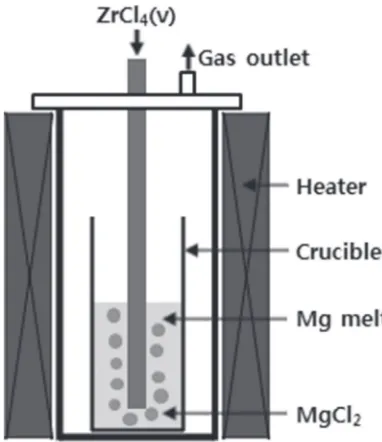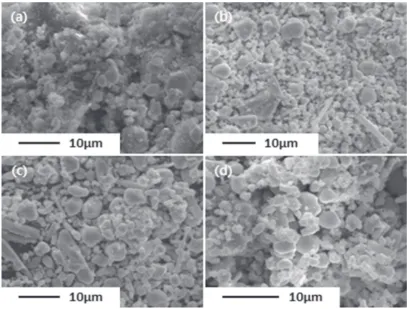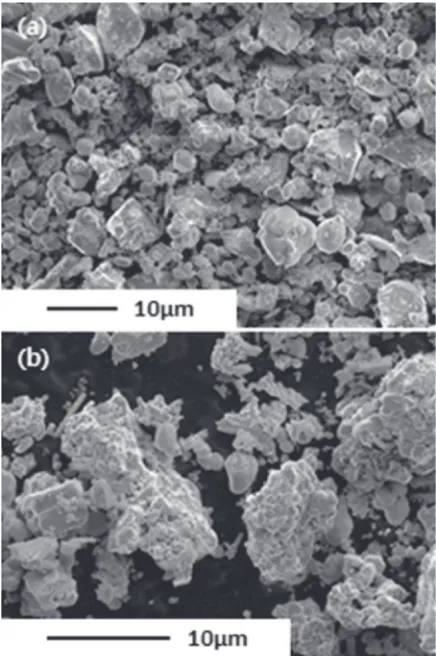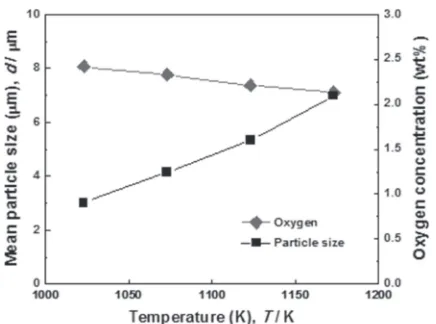Preparation of Zirconium Powder Through ZrCl
4Bubbling in Mg-MgCl
2Bath
Hyun-Na Bae
1,+1, Mi-Seon Choi
2, Go-Gi Lee
2and Seon-Hyo Kim
1,+2 1Department of Materials Science and Engineering, Pohang University of Science and Technology,77, Cheongam-ro, Nam-gu, Pohang-si, Gyeongsangbuk-do, 790-784, Korea 2Research Institute of Industrial Science and Techanology,
67, Cheongam-ro, Nam-gu, Pohang-si, Gyeongsangbuk-do, 790-330, Korea
An alternative process has been studied for zirconium production through chemical reaction between ZrCl4bubbles and magnesium melt
floating on molten MgCl2salt. The preparation of pure zirconium in the form of powder was successfully accomplished by cleaning process
consisting of washing with distilled water and pickling with hydrochloric acid solution. The purity of zirconium powder increased with dense concentration of hydrochloric acid solution and longer pickling time by removing residual magnesium, MgCl2and other impurities except for
zirconium. The sufficiently high level of purity was achieved by pickling for 6 hours using 3 mass%of hydrochloric acid solution. It was noteworthy that purity of zirconium powder was deteriorated with the formation of intermetallic compounds when alumina or iron was used for apparatus material. Meanwhile, a sound quality without any intermetallic compound and high purity were achieved when MgO material was used. It was found that there were no significant differences in purity and morphology of zirconium powder depending on reaction temperature. However, mean particle size was increased by increasing reaction temperature. [doi:10.2320/matertrans.M2015248]
(Received June 15, 2015; Accepted August 12, 2015; Published October 9, 2015)
Keywords: zirconium powder, ZrCl4bubble, cleaning, pickling, intermetallic compound
1. Introduction
Because of the attractive properties which are excellent corrosion resistance, great strength with ductility, thermal conductivity and biocompatible property, zirconium has been applied to various fields such as structural materials to aggressive environment, hardening agent to steel alloys, petrochemical industry and surgical appliances.14)Notably, a considerable amount of zirconium has been used for fuel rod cladding tube because of a small cross section for the absorption of thermal neutron.5,6)
The most well-known process to produce metallic zirconium is Kroll process.7,8) ZrCl4 in the form of powder is fed into the reactor whose temperature is maintained in a range of 10731123 K. Then, ZrCl4is vaporized, resulting in a reduction of ZrCl4on the surface of magnesium melt. As a result, a zirconium consisting of agglomeratedfine particles which is called zirconium sponge is formed. Thereafter, product is evaporated at 1273 K in a vacuum to remove residual magnesium and MgCl2contained in the porosity of the sponge. Consequently, Kroll process produces pure zirconium sponge. However, quality is not uniform, and it has a limitation for productivity enhancement due to the batch-type operation for reduction and vacuum distillation which are costly and time-consuming.
In this study, a bubble reduction method, which had been studied for titanium powder production,9) was investigated for a direct zirconium powder production from ZrCl4 as starting material. This method consists of two step; reduction and cleaning processes. Firstly, magnesium and MgCl2 are melted in the reactor. They are separated into two layers in which magnesium melt floats on MgCl2 salt due to the difference of specific gravity. Then, gaseous ZrCl4is injected to MgCl2 salt through the lance, leading to a conversion into a bubble. This floats without a reaction in MgCl2 salt.
Subsequently, it is reduced in magnesium layer, resulting in formation of zirconium particles. They are settled in bath due to the greater specific gravity than the two melts, and piled up on bottom of the reactor. Next, the product is cleaned through washing and pickling with an acid solution to remove excess magnesium and MgCl2 existing within zirconium particles. As result of that, a metallic zirconium powder is produced. This method has many merits. The produced zirconium powder has a uniform quality and high purity because there is pure gaseous ZrCl4/liquid magnesium reaction without contact with other phases. Cost-saving and less energy consumption are expected for zirconium powder production due to the simplified process compared to the conventional process which needs additional step such as HDH (Hydro-genation-dehydrogenation) process in that zirconium sponge is converted to ZrH2 by hydrogenation, and friable ZrH2 is milled for fine powder, in that order, they are converted to zirconium powder by dehydrogenation.10)
This study was performed to verify an experimental preparation of zirconium powder through chemical reaction between ZrCl4 bubbles and magnesium melt. Also, cleaning process was investigated to purify zirconium powder. The effects of apparatus materials and reaction temperature were studied.
2. Experimental Procedure
A schematic diagram of experimental apparatus for zirconium powder production is shown in Fig. 1. ZrCl4vapor formed in the exterior chamber was injected through the lance made of alumina. Reduction reaction was occurred in the crucible (55 mm dia. and 150 mm h.) mounted on bottom of the cylindrical steel reactor (80 mm dia. and 480 mm h.) in the furnace. The chamber and the reactor were connected by steel tube whose temperature was maintained at 673 K with heating tape to prevent condensation of ZrCl4vapor. All parts of the apparatus were covered by the insulating materials to block contact with air of room temperature.
+1Graduate Student, Pohang University of Science and Technology +2Corresponding author, E-mail: seonhyo@postech.ac.kr
30 g of ZrCl4 powder (²99.5%) was prepared for vapor-ization as reactant, and metallic magnesium chips (99.98%) 105 g and MgCl2 powder (98.0%) 230 g were served in the crucible made of MgO. In some cases, for comparison, iron and alumina materials were used for the crucible. The experiments were conducted at 10231173 K under atmos-pheric pressure which was maintained by emission of gaseous phases including argon gas and unreacted ZrCl4 vapor through the outlet of the reactor.
Experiment was proceeded as follows. Firstly, the furnace was heated to the operating temperature to melt magnesium and MgCl2, and they were stabilized in the crucible. The lance was immersed into the molten MgCl2salt. Then, ZrCl4 vapor was injected with carrier argon gas whose flow rate was 100 ml/min regulated byflowmeter. This was continued for 90 min. After that, the lance was pulled off from the melts, and followed by a cooling-down of furnace to room temperature. The crucible was taken out from the reactor to separate the inner materials. They were washed with distilled water, and pickled with hydrochloric acid solution. In that order, ethyl alcohol and acetone were used to rinse the residue. Subsequently, it was dried.
The obtained powder was analyzed via scanning electron microscopy equipped with energy dispersive X-ray spec-troscopy (SEM-EDS) for chemical composition and obser-vation of microstructure. The phases were identified by X-ray diffractometer (XRD). Inductively coupled plasma atomic emission spectroscopy (ICP-AES) was applied to determine the concentration of metallic elements. The oxygen concen-tration was determined by inert gas fusion-infrared absorpti-ometry technique (LECO analysis).
3. Results and Discussion
3.1 Zirconium powder preparation with cleaning proc-ess
The Kroll reduction process produces zirconium sponge, and vacuum distillation is used to remove the residue and
impurities for purification of zirconium. This, however, is not proper in this study because the loss of zirconium powder could exist. Accordingly, a wet cleaning method was adopted to obtain pure zirconium powder.
The washing using distilled water was carried out for 6 h with two times to remove MgCl2which is highly soluble in water.11) Then, precipitates were formed, and they were converted into the powder by drying. These were divided into four groups. Among them, three were pickled in hydrochloric acid solution of 15% for 12 h. The microstructures of the powders after drying are shown in Fig. 2.
Dust-like substances with small round particles were observed on the powder obtained by only washing. In EDS analysis, it was known that the powder contains oxygen, magnesium, aluminum and chlorine as well as zirconium. Meanwhile, a crowd of round particles was observed on the powder after pickling. In this case, impurities excepting for zirconium were hardly detected compared to the washed powder. In XRD analysis shown in Fig. 3, zirconium and magnesium compounds were found on the powder which was only washed. However, zirconium was mainly found after pickling. It means that pure zirconium powder was favorably achieved by cleaning process using distilled water and hydrochloric acid solution.
The product of the reduction experiment is a mixture of zirconium, magnesium and MgCl2. In addition, MgO was included in the product which was formed by oxidation of magnesium melt and reduction of the alumina lance as following reactions.
Mgþ0:5O2¼MgO; G1100o K¼ 482:1 kJ=mol12Þ ð1Þ 3MgþAl2O3¼3MgOþ2Al;
Go
1100K¼ 117:3 kJ=mol12Þ ð2Þ By washing, MgCl2was removed by dissolving in water, and Mg(OH)2was formed through the reaction (3).
MgOþH2O¼MgðOHÞ2; Go300K¼ 37:5 kJ=mol12Þð3Þ
The other impurities as well as Mg(OH)2 were removed by pickling with hydrochloric acid solution,13) resulting in obtaining pure metallic zirconium powder.
Elemental concentrations of the powder depending clean-ing process are listed in Table 1. The concentrations of magnesium and oxygen were diminished with the dense concentration of hydrochloric acid solution. Accordingly, the purity of zirconium was enhanced due to the fact that zirconium is hardly removed in acid solution as noble metal.14)In other words, zirconium powder with high purity was achieved by pickling in hydrochloric acid solution of high concentration. However, no considerable difference in quality was found between the cases of 3% and 5% of hydrochloric acid solution. Thus, 3% of hydrochloric acid solution is needed at least for efficiently removing impurities of the zirconium powder.
Different pickling time was applied in 3%of hydrochloric acid solution. As a result, it was hard tofind the relationship between pickling time and morphology of the powder. However, the purity of zirconium powder was changed as shown in Fig. 4. The maximum concentration of zirconium was reached to be 93.7 mass%by pickling for 6 hours, and it was hardly enhanced in 612 h. Oxygen concentration was
[image:2.595.71.262.69.290.2]minimized by pickling for 4 h and it slightly increased with more pickling time. This is because oxygen, which is soluble in the solution, might be adsorbed on the surface of
zirconium particles. However, oxygen concentration was hardly changed after 6 h. Consequently, it needs at least 6 h to achieve a successful pickling with hydrochloric acid solution of 3%for production of zirconium powder with a high level of purity.
3.2 Effect of materials
Figure 5 shows the powders obtained in the experiments using the crucible made of alumina and iron. When alumina crucible was used, the particle shape of the powder is angular and rugged. It was confirmed by EDS analysis that zirconium and aluminum were contained in the powder, which led to the formation of not only zirconium but also Al3Zr4and AlZr3as shown in Fig. 6. In Ellingham diagram, magnesium is more
[image:3.595.94.501.69.378.2]Fig. 3 X-ray diffraction patterns after (a) washing, (b) pickling (with HCl 5%).
Table 1 Effect of cleaning process on the purity of zirconium powder.
# Treatment Liquid solution Concentration/mass% Zr Mg Al O 1 Washing Distilled water 47.8 19.88 2.33 5.18 2 Pickling HCl 1% 92.1 0.51 3.18 2.41 3 Pickling HCl 3% 93.7 0.52 3.07 2.33 4 Pickling HCl 5% 93.6 0.51 3.09 2.31
Fig. 2 SEM images of the powder obtained at 1073 K after (a) washing, and pickling with HCl of (b) 1%, (c) 3%, (d) 5%.
[image:3.595.63.281.412.587.2] [image:3.595.321.528.414.571.2] [image:3.595.48.291.647.726.2]oxidized than aluminum.15) For that reason, metallic aluminum is reduced from Al2O3by strong reducing ability of magnesium melt. Subsequently, aluminum component is combined with zirconium, and then various compounds in Al-Zr phase diagram are formed.16)When iron crucible was used, agglomerated particles were shown on SEM observa-tion, and iron was detected as impurity. XRD analysis showed FeZr2 as well as zirconium for stable phases in the powder. It might be caused by iron diffusing from the surface of iron crucible.17)
Elemental concentrations depending on experimental conditions, which are determined by ICP-AES and LECO, are listed in Table 2. The powder obtained in alumina crucible has relatively high aluminum concentration. Like-wise, an iron concentration is relatively high in the case of
iron crucible. These impurities could lower the purity of zirconium powder due to the formation of intermetallic compounds by combining with zirconium.16,18)Meanwhile, a significant amount of impurity was not detected in the case of MgO crucible. In addition, no impure phase was observed. This is because magnesium and zirconium coexist without intermetallic compound formation in the range of 2.7 99.9 mass%Zr.19)Thus, a higher purity of zirconium powder could be achieved when MgO is used for apparatus material. Furthermore, MgO material was used for not only the crucible but also the lance. As a result, a purity of zirconium powder was improved with the decrease of aluminum concentration. However, oxygen concentration is higher than commercial zirconium sponge with oxygen of thousands ppm.20)Powder type of zirconium has a large specific surface area compared to the bulk type like zirconium sponge. Namely, comparatively a large amount of oxygen could be absorbed on zirconium powder due to the wide surface area to contact with oxygen. Also, soluble oxygen in MgCl2salt which is used for stable formation of ZrCl4bubbles could be an origin to increase oxygen concentration of the powder. Therefore, the utilization of the purified argon gas and MgCl2 salt whose oxygen concentration is very low could be a way to reduce oxygen concentration in the zirconium powder.
3.3 Effect of reaction temperature
Using the alumina lance and the MgO crucible, the experiments were conducted at temperature range of 1023
Fig. 5 SEM images of the powder manufactured at 1073 K by using the crucible made of (a) alumina, (b) iron.
[image:4.595.45.548.84.199.2]Fig. 6 X-ray diffraction patterns of the powders obtained in the crucible made of (a) alumina, (b) iron.
Table 2 Zirconium powder obtained in the different experimental conditions.
Crucible Lance Temperature (K)
Concentration/mass%
Morphology
Zr Mg Al Fe O
Al2O3 Al2O3 1073 84.0 0.35 14.07 ® 1.84 granular
Fe Al2O3 1073 72.3 0.29 3.17 21.39 2.98 agglomerated
MgO Al2O3 1073 93.7 0.52 3.07 ® 2.33 granular
MgO MgO 1073 95.6 0.43 0.77 ® 2.80 granular MgO Al2O3 1023 93.5 0.45 2.80 ® 2.42 granular
MgO Al2O3 1123 93.7 0.45 3.43 ® 2.21 granular
[image:4.595.316.537.218.398.2] [image:4.595.60.278.231.559.2]1173 K. Regardless of reaction temperature, round particles were observed in the most powders without a significant difference in shape. The chemical composition and the purity of the zirconium powder were hardly changed depending on reaction temperature. However, the considerable change was found in particle size. Figure 7 shows mean particle size as a function of reaction temperature, where the particle size was obtained from the SEM images by assistance of the software of Image Pro Plus v4.5.21)It was observed to be about 3 µm at 1023 K and 7 µm at 1173 K. The mean value in particle size of the zirconium powder increased by increasing reaction temperature, and then the oxygen concentration decreased. Oxygen might exist in the form of ZrO2film on the surface of zirconium particles piled on the crucible bottom.13) The particles grow with increasing temperature due to the increase of the rate of coalescence,22) thereby narrowing the spaces between the particles, in which oxygen could be trapped. This is why oxygen concentration decreased at higher temperature. In addition, smaller amount of oxygen could be absorbed on the surface of zirconium particles due to the larger particle size causing smaller specific surface area. Thus, zirconium powder with lower oxygen concentration is produced when the reaction temperature increased. Mean-while, the mass of magnesium melt would be reduced at high reaction temperature leading to the vaporization. For this reason, a very high reaction temperature has to be avoided for stable zirconium powder production.
4. Conclusions
The reduction reaction of ZrCl4 bubbles was verified for zirconium powder production by the experiments with ZrCl4 bubbling in Mg-MgCl2 bath. Subsequently, pure zirconium powder was achieved through the cleaning process consisting
of washing and pickling. Then, pickling with hydrochloric acid solution of 3%for 6 h was effective to remove efficiently impurities of the zirconium powder. The purity of zirconium powder reached to 95.6 mass%in the experiment using MgO materials for both the crucible and the lance at 1073 K. Meanwhile, alumina and iron materials caused the purity decrease with the formation of intermetallic compounds. The higher reaction temperature induced the increase of mean zirconium particle size, leading to the lower concentration of oxygen.
The zirconium powder produced in this study is appro-priate for pyrotechnic areas which require the purity more than 95.0 mass%. However, it is too low for highly effective getter which needs zirconium powder more than 98.0 mass%. Also, comparing the produced mass of zirconium powder and the consumed ZrCl4 mass, the yield is about 5070%. A scaled-up the process is subjected to further study for improvement of purity and yield.
REFERENCES
1) S. Nishio:Corros. Sci.65(2012) 567570.
2) K. T. Park, H. H. Nersisyan, S. I. Hong, N. C. Cho and J. H. Lee:Int. J. Refract. Metals. Hard Mater.33(2012) 3337.
3) S. S. Shin, K. M. Lim, E. S. Kim and J. C. Lee: Korean J. Met. Mater.
50(2012) 293299.
4) J. Y. Park, Y. H. Jeong and Y. H. Jung:Met. Mater. Int.7(2001) 447 455.
5) R. Mallikarjunan and J. C. Sehra:Bull. Mater. Sci.12(1989) 407434.
6) M. Griffiths and R. A. Holt:J. Nucl. Mater.225(1995) 245258.
7) W. J. Kroll:J. Franklin Inst.260(1955) 169192.
8) W. J. Kroll:Z. Anorg. Chem.234(1937) 4250.
9) T. N. Deura, T. Matsunaga, R. O. Suzuki, K. Ono and M. Wakino:
Metall. Mater. Trans. B29(1998) 11671174.
10) J. Park, W. Kim and M. Won:Mater. Trans.48(2007) 10121016.
11) I. Leusbrock, S. J. Metz, G. Rexwinkel and G. F. Versteeg:J. Supercrit. Fluids53(2010) 1724.
12) O. Knacke, O. Kubaschewski and K. Hesselmann:Thermochemical Properties of Inorganic Substances, (Springer-Verlag, Berlin, 1991). 13) D. W. Lee, J. Y. Yun, S. W. Yoon and J. P. Wang:Met. Mater. Int.19
(2013) 527532.
14) R. Subramanian, S. Sircar and J. Mazumder: J. Mater. Sci.26(1991) 951956.
15) D. R. Gaskell: Introduction to the Thermodynamics of Materials, (Taylor & Francis, New York, 2003) pp. 346364.
16) T. Wang, Z. Jin and J. C. Zhao:J. Phase Equilib.22(2001) 544551.
17) M. C. Schubert, J. Schon, F. Schindler, W. Kwapil, Al abdollahinia, B. Michl, S. Reipe, C. Schmid, M. Schumann, S. Meyer and W. Warta:
IEEE J. Photovolt.3(2013) 12501258.
18) M. Jiang, K. Oikawa, T. Ikeshoji, L. Wulff and K. Ishida: J. Phase Equilib.22(2001) 406417.
19) H. Okamoto:J. Phase Equilib.23(2002) 198199.
20) Zirconium Sponge Technical Data Sheet, Allegheny Technologies Incorporated (ATI) http://www.atimetals.com/Documents/zirconium_ sponge_v1.pdf, (accessed 2015-07-24).
21) Media Cybernetics, I., Image Pro Plus v4.5, Silver Spring (2005). 22) S. H. Ehrman, M. I. Aquino-Class and M. R. Zachariah:J. Mater. Res.
14(1999) 16641671.
[image:5.595.61.279.67.229.2]


